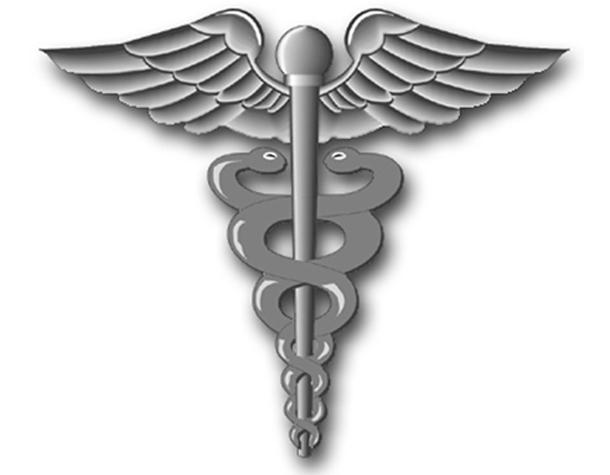
Medical Symbol (Wikimedia)
The universal medical symbol is a snake coiled around the Rod of Aesclepius, the Greco-Roman god of medicine. According to legend, Aesclepius, the man-god son of Apollo, learned to heal from both his deific father and his wise mentor, the Centaur Chiron. The Rod of Aesclepius has passed down to us as a paragon of the healing arts from ancient stories of this mythological figure’s medicinal exploits.
Aesclepius was hugely popular thousands of years ago. A holistic therapeutic tradition grew up around the tales of his mythical abilities, inspiring the construction of early hospital-like retreats called asklepions that provided proto-medical treatments to the sick and injured. The Greek healer’s cult retained an enormous following from the fifth century B.C. through the fourth century A.D. before being displaced by Christian ideologies.
As a born healer, Aesclepius had several nasty run-ins with the head honcho of the Greek pantheon, Zeus. In one version of the myth, Zeus killed Aesclepius with a choice thunderbolt for being so brash as to revive the dead. Zeus’ antagonism toward the talented son of Apollo concerned his ability to transcend human mortality, thereby threatening to make humans equal to the gods.
The ruler of the Olympians took the initiative to eliminate this threat. Overcome with killer’s remorse, however, Zeus later placed Aesclepius among the nighttime stars as the constellation ‘Ophiuchus,’ the Serpent-Bearer.
A Trip To the Asklepion
In ancient times, one of the best things you could do for yourself as a sick person was to visit a healing center dedicated to Aesclepius, called an asklepion. Although most towns had an asklepion, the seaside sanctury at Epidauros was the best known of them all.
Going to see the asklepion usually meant trekking to the nearest sanctuary and staying overnight. While sleeping, the diseased were said to have a dream in which Aesclepius appeared to them, accompanied by a serpent who might lick their wound, thus curing them of their physical ailment.
All dreams were reported to the physician-priest the next morning, who would then make recommendations as to further action that should be taken. The doctor’s orders included such activities as taking long walks, resting in baths, and exercising in the on-site gymnasium.
A sacred species called the Aesculapian snake was encouraged around the asklepion campus, and would often slither around in the dormitory where sick individuals slept in hopes of dreaming a curative dream. Today, we know the Aesculapian snake as Zamenis longissimus, a nonvenomous rat snake native to southeastern Europe.
Snakes: Symbol of Healing or Epitome of Danger?
Few animals have been as extensively mythologized as snakes. Some of the earliest known cultural expressions take up the serpentine theme, depicting snakes as the incarnation of evil or, conversely, as medical symbols, life-giving signs of therapeutic renewal. It depends on who, when, and where you ask.
Modern Western civilization has inherited this ambivalence. Fear of snakes is one of the most common phobias, and snakes are widely thought to be disgusting and dangerous. Yet, groups like the American Medical Association have drawn on the iconic, snake-coiled Rod of Aesclepius as a universally-recognized symbol of medicine to represent themselves.
Bonus Facts To Arouse Your Curiosity
Earliest Medical Schools
Interestingly, the asklepion sanctuaries to which the sick and diseased retreated for healing also functioned as early medical schools. Such famous forbearers of modern medicine as Hippocrates and Galen received their medical education in these establishments.
Aesculapian vs. the Caduceus
The Rod of Aesclepius is often confused with the walking stick or staff of Hermes, the Greek god of commerce, travel and peace, among other things. Hermes had a staff because he regularly accompanied people that had died to the underworld — not a very comforting image for someone with an imminent medical issue.
Pagan vs. Christian Serpentine Symbolism
For the ancient Greeks who conceived the Aesclepian tradition, the snake symbolized healing and the renewal of life, drawing attention to the shedding of the skin as part of its life cycle. Yet some snakes are, of course, venomous and can kill those who disturb them. This dangerous or uncontrollable aspect is emphasized by Christian tradition from the third century B.C. onwards, as seen in the biblical depiction of the serpent as the genesis of evil.